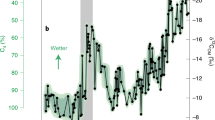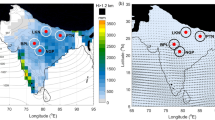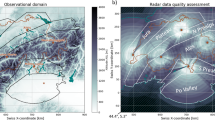Abstract
Thunderstorms in the Southern Great Plains of the United States are among the strongest on Earth and have been shown to be increasing in intensity and frequency during recent years. Assessing changes in storm characteristics under different climate scenarios, however, remains highly uncertain due to limitations in climate model physics. We analyse oxygen isotopes from Texas stalactites from 30–50 thousand years ago to assess past changes in thunderstorm size and duration using a modern radar-based calibration for the region. Storm regimes shift from weakly to strongly organized on millennial timescales and are coincident with well-known abrupt climate shifts during the last glacial period. Modern-day synoptic analysis suggests that thunderstorm organization in the Southern Great Plains is strongly coupled to changes in large-scale wind and moisture patterns. These changes in the large-scale circulation may be used to assess future predictions and palaeo-simulations of mid-latitude thunderstorm climatologies.
This is a preview of subscription content, access via your institution
Access options
Access Nature and 54 other Nature Portfolio journals
Get Nature+, our best-value online-access subscription
$29.99 / 30 days
cancel any time
Subscribe to this journal
Receive 12 print issues and online access
$259.00 per year
only $21.58 per issue
Buy this article
- Purchase on Springer Link
- Instant access to full article PDF
Prices may be subject to local taxes which are calculated during checkout




Similar content being viewed by others
Data availability
All speleothem isotopic data measured in this study will be archived in the Paleoclimatology Dataset repository in the National Centers for Environmental Information, NOAA database (https://www.ncdc.noaa.gov/data-access/paleoclimatology-data/datasets). All rainfall isotope data will be publicly archived in the Waterisotopes Database (http://wateriso.utah.edu/waterisotopes/index.html).
Code availability
The Jupyter Notebooks use public, open-source packages to perform all Python calculations and generate all figures herein, and are available upon request to the corresponding author.
References
Smith, J. A., Baeck, M. L., Morrison, J. E. & Sturdevant-Rees, P. Catastrophic rainfall and flooding in Texas. J. Hydrometeorol. 1, 5–25 (2000).
Wang, S. S.-Y., Huang, W.-R., Hsu, H.-H. & Gillies, R. R. Role of the strengthened El Niño teleconnection in the May 2015 floods over the southern Great Plains. Geophys. Res. Lett. 42, 8140–8146 (2015).
Schumacher, R. S. & Rasmussen, K. L. The formation, character and changing nature of mesoscale convective systems. Nat. Rev. Earth Environ. 1, 300–314 (2020).
Liu, C. & Zipser, E. J. The global distribution of largest, deepest, and most intense precipitation systems. Geophys. Res. Lett. 42, 3591–3595 (2015).
Houze, R. A. Jr. Mesoscale convective systems. Rev. Geophys. https://doi.org/10.1029/2004RG000150 (2004).
Nesbitt, S. W., Cifelli, R. & Rutledge, S. A. Storm morphology and rainfall characteristics of TRMM precipitation features. Mon. Weather Rev. 134, 2702–2721 (2006).
Fritsch, J. M., Kane, R. J. & Chelius, C. R. The contribution of mesoscale convective weather systems to the warm-season precipitation in the United States. J. Clim. Appl. Meteorol. 25, 1333–1345 (1986).
Nielsen-Gammon, J. The 2011 Texas drought. Texas Water J. 3, 59–95 (2012).
Feng, Z. et al. More frequent intense and long-lived storms dominate the springtime trend in central US rainfall. Nat. Commun. 7, 13429 (2016).
Kloesel, K. et al. in Impacts, Risks, and Adaptation in the United States: Fourth National Climate Assessment Vol. II (eds Reidmiller, D. R. et al.) 987–1035 (US Global Change Research Program, 2018).
Thirumalai, K., Singh, A. & Ramesh, R. A MATLAB code to perform weighted linear regression with (correlated or uncorrelated) errors in bivariate data. J. Geol. Soc. India 77, 377–380 (2011).
Merlivat, L. & Jouzel, J. Global climatic interpretation of the deuterium-oxygen 18 relationship for precipitation. J. Geophys. Res. Oceans 84, 5029–5033 (1979).
Merlivat, L. Molecular diffusivities of H\({\,}_{2}^{16}\)O, HD16O, and H\({\,}_{2}^{16}\)O in gases. J. Chem. Phys. 69, 2864–2871 (1978).
Horita, J. & Wesolowski, D. J. Liquid-vapor fractionation of oxygen and hydrogen isotopes of water from the freezing to the critical temperature. Geochim. Cosmochim. Acta 58, 3425–3437 (1994).
Aggarwal, P. K. et al. Proportions of convective and stratiform precipitation revealed in water isotope ratios. Nat. Geosci. 9, 624–629 (2016).
Botev, Z. I., Grotowski, J. F. & Kroese, D. P. Kernel density estimation via diffusion. Ann. Stat. 38, 2916–2957 (2010).
Lawrence, J. R. et al. Stable isotopic composition of water vapor in the tropics. J. Geophys. Res. Atmos. https://doi.org/10.1029/2003JD004046 (2004).
Yang, M.-H. & Houze, R. A. Sensitivity of squall-line rear inflow to ice microphysics and environmental humidity. Mon. Weather Rev. 123, 3175–3193 (1995).
Kurita, N. Water isotopic variability in response to mesoscale convective system over the tropical ocean. J. Geophys. Res. Atmos. 118, 10376–10390 (2013).
Lawrence, J. R. & Gedzelman, S. D. Tropical ice core isotopes: do they reflect changes in storm activity? Geophys. Res. Lett. https://doi.org/10.1029/2002GL015906 (2003).
Tuttle, J. D. & Davis, C. A. Corridors of warm season precipitation in the central United States. Mon. Weather Rev. 134, 2297–2317 (2006).
Pape, J. R., Banner, J. L., Mack, L. E., Musgrove, M. & Guilfoyle, A. Controls on oxygen isotope variability in precipitation and cave drip waters, central Texas, USA. J. Hydrol. 385, 203–215 (2010).
Sun, C., Shanahan, T. M. & Partin, J. Controls on the isotopic composition of precipitation in the south-central United States. J. Geophys. Res. Atmos. 124, 8320–8335 (2019).
Dansgaard, W. et al. Evidence for general instability of past climate from a 250-kyr ice-core record. Nature 364, 218–220 (1993).
Svensson, A. et al. A 60 000 year Greenland stratigraphic ice core chronology. Clim. Past 4, 47–57 (2008).
Böhm, E. et al. Strong and deep Atlantic meridional overturning circulation during the last glacial cycle. Nature 517, 73–76 (2014).
Henry, L. G. et al. North Atlantic ocean circulation and abrupt climate change during the last glaciation. Science 353, 470–474 (2016).
Zhang, X., Lohmann, G., Knorr, G. & Purcell, C. Abrupt glacial climate shifts controlled by ice sheet changes. Nature 512, 290–294 (2014).
Voelker, A. H. Global distribution of centennial-scale records for Marine Isotope Stage (MIS) 3: a database. Quat. Sci. Rev. 21, 1185–1212 (2002).
Gibson, K. A. & Peterson, L. C. A 0.6 million year record of millennial-scale climate variability in the tropics. Geophys. Res. Lett. 41, 969–975 (2014).
Members, W. D. P. Precise interpolar phasing of abrupt climate change during the last ice age. Nature 520, 661–665 (2015).
Musgrove, M., Solder, J., Opsahl, S. & Wilson, J. Timescales of water-quality change in a karst aquifer, south-central Texas. J. Hydrol. X 4, 100041 (2019).
Dreybrodt, W. & Scholz, D. Climatic dependence of stable carbon and oxygen isotope signals recorded in speleothems: from soil water to speleothem calcite. Geochim. Cosmochim. Acta 75, 734 – 752 (2011).
Kim, S.-T. & O’Neil, J. R. Equilibrium and nonequilibrium oxygen isotope effects in synthetic carbonates. Geochim. Cosmochim. Acta 61, 3461–3475 (1997).
Banner, J., Guilfoyle, A., James, E., Stern, L. & Musgrove, M. Seasonal variations in modern speleothem calcite growth in Central Texas, U.S.A. J. Sediment. Res. 77, 615–622 (2007).
Feng, W., Banner, J. L., Guilfoyle, A. L., Musgrove, M. & James, E. W. Oxygen isotopic fractionation between drip water and speleothem calcite: a 10-year monitoring study, central Texas, USA. Chem. Geol. 304–305, 53–67 (2012).
Hill, H. W., Flower, B. P., Quinn, T. M., Hollander, D. J. & Guilderson, T. P. Laurentide Ice Sheet meltwater and abrupt climate change during the last glaciation. Paleoceanography https://doi.org/10.1029/2005PA001186 (2006).
Menviel, L., Timmermann, A., Friedrich, T. & England, M. H. Hindcasting the continuum of Dansgaard–Oeschger variability: mechanisms, patterns and timing. Clim. Past 10, 63–77 (2014).
Zhang, X., Knorr, G., Lohmann, G. & Barker, S. Abrupt North Atlantic circulation changes in response to gradual CO2 forcing in a glacial climate state. Nat. Geosci. 10, 518–523 (2014).
Peterson, T. C. & Vose, R. S. An overview of the Global Historical Climatology Network Temperature Database. Bull. Am. Meteorol. Soc. 78, 2837–2850 (1997).
Zhang, X., Prange, M., Merkel, U. & Schulz, M. Instability of the Atlantic overturning circulation during Marine Isotope Stage 3. Geophys. Res. Lett. 41, 4285–4293 (2014).
Laing, A. G. & Fritsch, J. M. The large-scale environments of the global populations of mesoscale convective complexes. Mon. Weather Rev. 128, 2756–2776 (2000).
Wang, S.-Y., Davies, R. E. & Gillies, R. R. Identification of extreme precipitation threat across midlatitude regions based on short-wave circulations. J. Geophys. Res. Atmos. 118, 11059–11074 (2013).
Ting, M. & Wang, H. The role of the North American topography on the maintenance of the Great Plains summer low-level jet. J. Atmos. Sci. 63, 1056–1068 (2006).
Hendy, I. L. & Kennett, J. P. Dansgaard-Oeschger Cycles and the California Current system: planktonic foraminiferal response to rapid climate change in Santa Barbara Basin, Ocean Drilling Program Hole 893A. Paleoceanography 15, 30–42 (2000).
Asmerom, Y., Polyak, V. J. & Burns, S. J. Variable winter moisture in the southwestern United States linked to rapid glacial climate shifts. Nat. Geosci. 3, 114–117 (2010).
Li, W., Li, L., Ting, M. & Liu, Y. Intensification of Northern Hemisphere subtropical highs in a warming climate. Nat. Geosci. 5, 830–834 (2012).
Knapp, K. R. et al. Globally gridded satellite observations for climate studies. Bull. Am. Meteorol. Soc. 92, 893–907 (2011).
Chen, M. et al. Assessing objective techniques for gauge-based analyses of global daily precipitation. J. Geophys. Res. Atmos. https://doi.org/10.1029/2007JD009132 (2008).
Wagner, J. D. M. et al. Moisture variability in the southwestern United States linked to abrupt glacial climate change. Nat. Geosci. 3, 110–113 (2016).
Bereiter, B. et al. Mode change of millennial CO2 variability during the last glacial cycle associated with a bipolar marine carbon seesaw. Proc. Natl Acad. Sci. USA 109, 9755–9760 (2012).
Huffman, G. J. et al. The Global Precipitation Climatology Project (GPCP) combined precipitation dataset. Bull. Am. Meteorol. Soc. 78, 5–20 (1997).
Kalnay, E. et al. The NCEP/NCAR 40-year reanalysis project. Bull. Am. Meteorol. Soc. 77, 437–472 (1996).
Cheng, H. et al. Improvements in 230Th dating, 230Th and 234U half-life values, and U-Th isotopic measurements by multi-collector inductively coupled plasma mass spectrometry. Earth Planet. Sci. Lett. 371–372, 82–91 (2013).
Maupin, C. R. et al. Persistent decadal-scale rainfall variability in the tropical south pacific convergence zone through the past six centuries. Clim. Past 10, 1319–1332 (2014).
Gupta, P., Noone, D., Galewsky, J., Sweeney, C. & Vaughn, B. H. Demonstration of high-precision continuous measurements of water vapor isotopologues in laboratory and remote field deployments using wavelength-scanned cavity ring-down spectroscopy (WS–CRDS) technology. Rapid Commun. Mass Spectrom. 23, 2534–2542 (2009).
Kluyver, T. et al. in Positioning and Power in Academic Publishing: Players, Agents and Agendas (eds Loizides, F. & Schmidt, B.) 87–90 (IOS Press, 2016).
Hunter, J. D. Matplotlib: A 2D graphics environment. Comput. Sci. Eng. 9, 90–95 (2007).
McKinney, W. Data structures for statistical computing in Python. In Proceedings of the 9th Python in Science Conference (eds van der Walt, S. & Millman, J.) 51–56 (2010).
Oliphant, T. NumPy v.1.19.5 (2006).
Odland, T. KDEpy v.0.9.10 (2018).
Waskom, M. et al. Seaborn v.0.9.0 (2018).
Hoyer, S. & Hamman, J. xarray: N-D labeled arrays and datasets in Python. J. Open Res. Software https://doi.org/10.5334/jors.148 (2017).
Cartopy: a cartographic python library with a matplotlib interface (Met Office, 2015); https://scitools.org.uk/cartopy/docs/latest/
Jones, E. et al. SciPy: Open source scientific tools for Python (2001); www.scipy.org
Acknowledgements
We acknowledge T. Bhattacharya, S. B. Malevich, G. Boyd and the Williamson County Conservation Foundation. We are grateful for constructive feedback from N. Levin. We thank Y.-C. Chou for conducting U/Th dating in the High-precision Mass Spectrometry and Environment Change Laboratory (HISPEC), Department of Geosciences, National Taiwan University. Funding was provided in part by a Texas A&M University high-impact undergraduate research grant. K.T. acknowledges support from the University of Arizona Technology and Research Initiative Fund (TRIF). U/Th dating was supported by the Science Vanguard Research Program of the Ministry of Science and Technology (108-2119-M-002-012) and the Higher Education Sprout Project of the Ministry of Education, Taiwan ROC (108L901001).
Author information
Authors and Affiliations
Contributions
C.R.M. and E.B.R. developed the concept. C.R.M., E.B.R., C.S., K.T., J.W.P. and C.-C.S. analysed results. E.B.R. acquired undergraduate research funding. C.R.M., A.L.H. and C.L.M. micromilled stalactite subsamples, and performed water and carbonate stable isotope measurements; O.B., Y.-C.C., T.-L.Y. and C.-C.S. subsampled and measured U and Th compositions; K.W. and S.V.K.-L. collected sample stalactites; C.R.M. and S.V.K.-L. collected daily rainfall samples. C.R.M. and J.W.P. developed the approach for screening high-232Th; C.R.M. and C.S. developed the storm categorization scheme; E.B.R., T.-L.Y. and C.-C.S. administered laboratory, personnel and instrumental resources; K.W. and S.V.K.-L. supervised sample collection, surveys and environmental impact assessments. C.R.M. wrote or implemented code for analysing investigation results with assistance from K.T.; C.R.M. and K.T. designed visualizations for investigation results. C.R.M. wrote the original draft. All authors contributed to review and editing of submitted manuscript.
Corresponding author
Ethics declarations
Competing interests
The authors declare no competing interests.
Additional information
Peer review information Nature Geoscience thanks Naomi Levin and the other, anonymous, reviewer(s) for their contribution to the peer review of this work. Primary Handling Editor: James Super.
Publisher’s note Springer Nature remains neutral with regard to jurisdictional claims in published maps and institutional affiliations.
Extended data
Extended Data Fig. 1 Age Model for stalactite 14FM2243-C (depicted with both U/Th and stable isotope subsample transects).
a, Calculated U/Th ages, relative to the date of subsample preparation for U and Th analyses, in thousands of years (ky) before 1950 CE (BP), plotted as burnt orange closed circles versus stalactite depth. Depth refers to distance from stalactite tip, increasing towards the cave ceiling; zero mm is the youngest calcite subsampled for δ18Oc. Error bars depict ± 2σ analytical uncertainty of U/Th analyses. The line and shaded envelope shows the median, and 10th to 90th percentile distributions of our age model, respectively; estimated by fitting N = 1,000 splines in the Bchron software package4. b, 232Th versus depth, exhibiting consistent, low32part-per-billion concentrations irrespective of sample depth. c, A histogram and Gaussian KDE of 232Th concentrations highlight the narrow distribution of232Th values.
Extended Data Fig. 2 Age Model for stalactite 13RM620-B (depicted with both U/Th and stable isotope subsample transects).
a, As in Extended Data Fig. 1a, except the youngest calcite subsampled for δ18Oc begins 40.25 mm from the tip; a hiatus immediately above this depth results in an abrupt transition into higher-232Th calcite (not shown). Dates plotted in blue were excluded from age model construction due to high 232Th concentrations, indicating relatively abundant non-radiogenic thorium and requiring larger age corrections with uncertain initial 230Th/232Th values. b,c, As in Extended Data Fig. 1b and c. The consistent, part per billion concentrations of included ages can be contrasted with the variable, higher-232Th character of excluded ages irrespective of depth.
Extended Data Fig. 3 Cross-sectional view representative of sample-void overburdens.
Note the shallow Edwards Limestone epikarst ( < 3 m), highlighted by the white bracket.
Extended Data Fig. 4 Overhead perspective of karst-void ceiling breached during trenching.
Note abundant fracture sets (white arrows), permitting recharge from any rainfall sufficient to exceed surface alluvium storage capacity and evapotranspiration. Voids breached and surveyed maintained 100% relative humidity and actively dripping groundwater infiltration.
Extended Data Fig. 5 Fastest and slowest growth axis δ18Oc in stalactite 14FM2243-C.
The reproducibility indicates kinetic effect concerns are not warranted for interpretations of sample calcite δ18O.
Extended Data Fig. 6 Mean annual streamfunction and mean annual temperature correlations, 1981-2018.
Monthly point-correlations between central Texas mean annual 10 m air temperature5, global gridded 10 m mean annual air temperature (over land)5, and global gridded mean annual SST6 (P < 10−3 diagonally hatched). Streamfunction here is calculated from the mean annual 10 m U and V wind components5. The yellow triangle denotes our central Texas study site, while the red circles locate Gulf of Mexico MIS3 SST reconstructions7,8.
Rights and permissions
About this article
Cite this article
Maupin, C.R., Roark, E.B., Thirumalai, K. et al. Abrupt Southern Great Plains thunderstorm shifts linked to glacial climate variability. Nat. Geosci. 14, 396–401 (2021). https://doi.org/10.1038/s41561-021-00729-w
Received:
Accepted:
Published:
Issue Date:
DOI: https://doi.org/10.1038/s41561-021-00729-w
This article is cited by
-
Dynamic and thermodynamic influences on precipitation in Northeast Mexico on orbital to millennial timescales
Nature Communications (2023)
-
Great Plains storm intensity since the last glacial controlled by spring surface warming
Nature Geoscience (2021)



